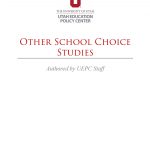
Sun, M. & Ni, Y. (2015). Work environments and labor markets: Explaining principal turnover gap between charter schools and traditional public schools. Educational Administration Quarterly. In press, 11/2015.
Ni, Y., Sun, M., & Rorrer, A. (2014). Principal turnover: Upheaval and uncertainty in charter schools? Educational Administration Quarterly. Published, 06/2014.
Gulosino, C. & Ni, Y. (2014). Home Schooling. In Brewer, D. J. & Picus, L. O. (Eds.). Encyclopedia of Education Economics and Finance. SAGE Publications Inc. Published, 09/2014.
Ni, Y., & Rorrer, A. (2012). Twice considered: Charter schools and student achievement in Utah. Economics of Education Review. 31(5), 835-849. Published, 02/2012.
Ni, Y. (2012). Teacher working conditions in charter schools and traditional public schools: A comparative study. Teachers College Record. 114(3), 1-26. Published, 06/2011.
Arsen, D & Ni, Y. (2012). Resource allocation in charter and traditional public schools: Is administration leaner in charter schools? Educational Policy Analysis Archives, 20(31). Published, 09/2012.
Arsen, D. & Ni, Y. (2012). The effects of charter school competition on school district resource allocation.Educational Administration Quarterly. 48(1), 3-38.. Published, 09/2012.
Arsen, D. & Ni, Y. (2012). The competitive effect of school choice policies on public school performance. In Hinchey, P., Welner, K, & Mrion, G. (Eds). School Choice: Evidence and Recommendations. Information Age Publications. Published, 10/2011.
Ni, Y. & Arsen, D. (2011). School choice participation rates: Which districts are pressured? Educational Policy Analysis Archives. 19(29). Published, 10/2011.
Arsen, D & Ni, Y. (2011). Shaking up public schools with competition: What does evidence say about the effects of charter schools on improving outcomes for nonchoosers and their schools? School Administrator.68(7), 16-19. Published, 08/2011.
Arsen, D. & Ni, Y. (2011). How Does District Resource Allocation Change in Response to Charter School Competition? In Berends, M, Cannata, M. & Goldring, E. (Eds). School Choice and School Improvement: Research in State, District and Community Contexts. Harvard Education Press. Published, 03/2011.
Ni, Y. (2010). The sorting effect of charter schools on student composition in traditional public schools.Educational Policy, 26(2), 3-30. Published, 12/2010.
Ni, Y. & Arsen, D. (2010). The competitive effects of charter schools on public school districts. In C. Lubienski (Eds). The charter school experiment: expectations, advocacy and evidence. Harvard Education Press. Published, 10/2010.
Ni, Y. & Arsen, D. (2009). Impacts of school choice competition on traditional public schools: Which districts are pressured, how do they respond? In F. E. Crampton (Ed.) Proceedings of the 2008 University Council for Educational Administration Conference. Austin, TX: UCEA. Published, 10/2009.
Ni, Y. (2009). The impact of charter schools on the efficiency of traditional public schools: Evidence from Michigan. Economics of Education Review. 28(5), 571-584. Published, 08/2009.
Arsen, D. and Ni, Y. (2008). The competitive effect of school choice policies on performance in traditional public schools. (No. EPSL-0803-261-EPRU). Tempe, AZ and Boulder, CO: Education Policy Research Unit, Arizona State University & Education and the Public Interest Center, University of Colorado. Published, 12/2008.
Ni, Y. (2008). What do we know about vouchers? A balanced and cautious perspective. Utah Education Policy Center, University of Utah. Published, 10/2007.
Ni, Y. (2007). Are charter schools more racially segregated than traditional public schools? The Education Policy Center at Michigan State University. Policy Report #30. Published, 05/2007.
Ni, Y. (2007). Who participates in Michigan’s school choice programs? The Education Policy Center at Michigan State University. Policy Report #29. Published, 03/2007.
